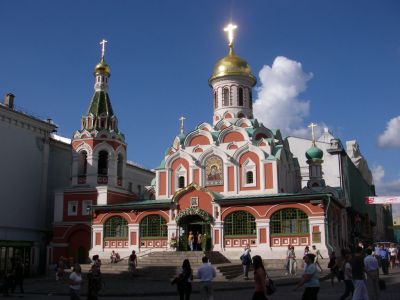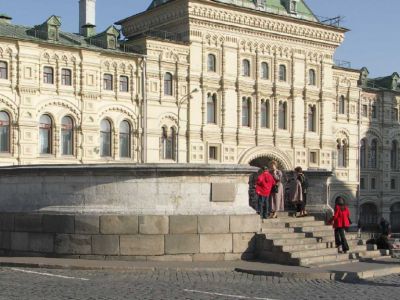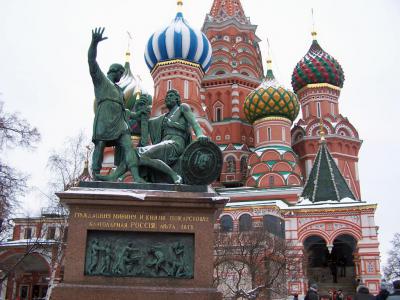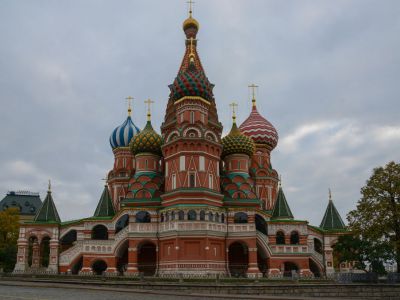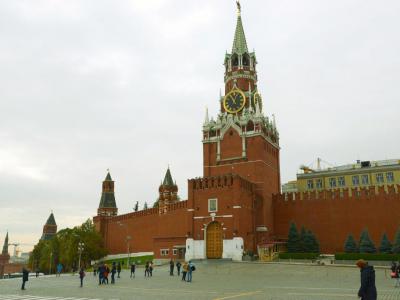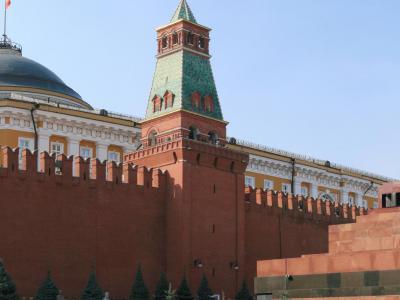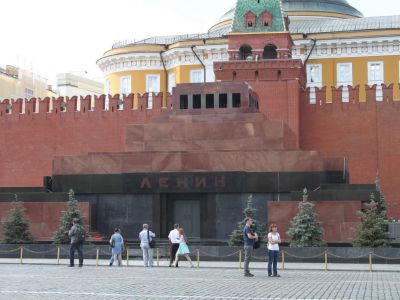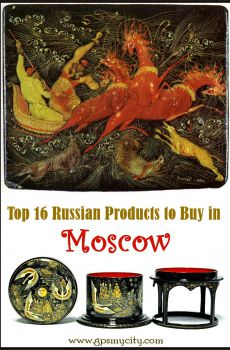
Red Square Walking Tour (Self Guided), Moscow
There's hardly any place in Russia more popular than Moscow's Red Square. Marking the center of the city, Red Square indeed represents in many ways the very heart of the Russian capital and the whole country. Built in the late 15th century, it has been a focal point in Russia's social and political life ever since, witnessing many historic and sometimes dramatic events including executions, demonstrations, and military parades.
As a designated UNESCO World Heritage Site, the square is home to some of the most important landmarks in Russia. One of them is the Iberian Gate, the only gate still in place leading into the square. Complete with a small chapel, it was reconstructed after demolition during the Soviet era.
Kazan Cathedral is another stunning site next to it. This impressive Russian Orthodox church is a replica of the original destroyed by the Bolsheviks in the 1930s. Nearby, there's the GUM Department Store, a massive shopping center that offers a mix of high-end and more affordable merchandise.
Lobnoye Mesto is a raised platform in the square where important announcements and ceremonies took place in the past. Right beside it stands the Monument to Minin and Pozharsky, which honors two national heroes of Russia.
Saint Basil's Cathedral, with its colorful and intricate domes, is perhaps the most recognizable building in Red Square. This iconic symbol of Russia makes a perfect photo-op.
Two grand towers, the Spasskaya and Senatskaya Towers, form parts of the Kremlin Wall. The Spasskaya Tower is known for its chimes, marking time for Muscovites for centuries. In front of them, Lenin's Mausoleum is a solemn place where you can pay respects to Vladimir Lenin, a prominent figure in Russian history.
Nikolskaya Tower is yet another impressive bastion, and nearby, you can explore the State Historical Museum to learn more about Russia's past.
If you ever get the chance to visit Moscow at least for one day, don't miss the opportunity to explore Red Square and its remarkable sites. You'll be immersed in the history and beauty of Russia, and it's an experience worth cherishing forever!
As a designated UNESCO World Heritage Site, the square is home to some of the most important landmarks in Russia. One of them is the Iberian Gate, the only gate still in place leading into the square. Complete with a small chapel, it was reconstructed after demolition during the Soviet era.
Kazan Cathedral is another stunning site next to it. This impressive Russian Orthodox church is a replica of the original destroyed by the Bolsheviks in the 1930s. Nearby, there's the GUM Department Store, a massive shopping center that offers a mix of high-end and more affordable merchandise.
Lobnoye Mesto is a raised platform in the square where important announcements and ceremonies took place in the past. Right beside it stands the Monument to Minin and Pozharsky, which honors two national heroes of Russia.
Saint Basil's Cathedral, with its colorful and intricate domes, is perhaps the most recognizable building in Red Square. This iconic symbol of Russia makes a perfect photo-op.
Two grand towers, the Spasskaya and Senatskaya Towers, form parts of the Kremlin Wall. The Spasskaya Tower is known for its chimes, marking time for Muscovites for centuries. In front of them, Lenin's Mausoleum is a solemn place where you can pay respects to Vladimir Lenin, a prominent figure in Russian history.
Nikolskaya Tower is yet another impressive bastion, and nearby, you can explore the State Historical Museum to learn more about Russia's past.
If you ever get the chance to visit Moscow at least for one day, don't miss the opportunity to explore Red Square and its remarkable sites. You'll be immersed in the history and beauty of Russia, and it's an experience worth cherishing forever!
How it works: Download the app "GPSmyCity: Walks in 1K+ Cities" from Apple App Store or Google Play Store to your mobile phone or tablet. The app turns your mobile device into a personal tour guide and its built-in GPS navigation functions guide you from one tour stop to next. The app works offline, so no data plan is needed when traveling abroad.
Red Square Walking Tour Map
Guide Name: Red Square Walking Tour
Guide Location: Russia » Moscow (See other walking tours in Moscow)
Guide Type: Self-guided Walking Tour (Sightseeing)
# of Attractions: 11
Tour Duration: 1 Hour(s)
Travel Distance: 1.0 Km or 0.6 Miles
Author: audrey
Sight(s) Featured in This Guide:
Guide Location: Russia » Moscow (See other walking tours in Moscow)
Guide Type: Self-guided Walking Tour (Sightseeing)
# of Attractions: 11
Tour Duration: 1 Hour(s)
Travel Distance: 1.0 Km or 0.6 Miles
Author: audrey
Sight(s) Featured in This Guide:
- Iberian Gate and Chapel
- Kazan Cathedral
- GUM Department Store
- Lobnoye Mesto
- Monument to Minin and Pozharsky
- St. Basil's Cathedral
- Spasskaya Tower
- Senatskaya Tower
- Lenin's Mausoleum
- Nikolskaya Tower
- State Historical Museum
1) Iberian Gate and Chapel
The Iberian Gate (Russian: Iverskie Vorota), also known as the Resurrection Gate (Russian: Voskresenskie Vorota), and its Chapel together make up the reconstructed ceremonial entrance to Red Square. It is also the only existing gate of Moscow's Kitai-gorod, and gives its name to the nearby Voskresenskaya (Resurrection) Square.
The very first stone gate on this site, initially called the Neglinensky gate, was built in 1535. In 1669 it was rebuilt and housed the Panaghia Portaitissa ("keeper of the gate") Icon, an exact replica of the Iberian Holy Mother of God Icon well-known for its miraculous abilities, brought from Athos in 1648.
To protect the icon from weather elements, it was placed in a chapel built in front of the gate, facing away from Red Square, in 1680. Subsequently, the name Iversky ("Iberian") stuck to both, the chapel and the gate. Another icon – of the Resurrection – was placed on the gate facing Red Square and gave it a second name.
A popular custom prescribed anyone walking to Red Square or the Kremlin to kiss the Iberian icon prior to entering the gate, and for men to remove their hats. The cramped temple was always filled with worshipers: beggars and outlaws could be seen praying alongside the highest royalty and the Tsar himself.
After the Revolution, the chapel was repeatedly robbed and stripped of all its valuables through confiscation, including the revered Iberian icon. In 1931, the Soviets decided to clear space for the passage of heavy machinery during annual military parades, and the gate and the chapel were demolished.
Following the fall of the Soviet Union, both structures were rebuilt in 1994-1995, and a new copy of the Iveron Theotokos Icon was purposely painted on Mount Athos. This new image has already become famous for many miracles of its own.
Over the years, the chapel appeared in a number of works by Leo Tolstoy, Ivan Bunin, Marina Tsvetayeva, and H.G. Wells. Just in front of it is a bronze plaque marking kilometer zero of the Russian road network.
The very first stone gate on this site, initially called the Neglinensky gate, was built in 1535. In 1669 it was rebuilt and housed the Panaghia Portaitissa ("keeper of the gate") Icon, an exact replica of the Iberian Holy Mother of God Icon well-known for its miraculous abilities, brought from Athos in 1648.
To protect the icon from weather elements, it was placed in a chapel built in front of the gate, facing away from Red Square, in 1680. Subsequently, the name Iversky ("Iberian") stuck to both, the chapel and the gate. Another icon – of the Resurrection – was placed on the gate facing Red Square and gave it a second name.
A popular custom prescribed anyone walking to Red Square or the Kremlin to kiss the Iberian icon prior to entering the gate, and for men to remove their hats. The cramped temple was always filled with worshipers: beggars and outlaws could be seen praying alongside the highest royalty and the Tsar himself.
After the Revolution, the chapel was repeatedly robbed and stripped of all its valuables through confiscation, including the revered Iberian icon. In 1931, the Soviets decided to clear space for the passage of heavy machinery during annual military parades, and the gate and the chapel were demolished.
Following the fall of the Soviet Union, both structures were rebuilt in 1994-1995, and a new copy of the Iveron Theotokos Icon was purposely painted on Mount Athos. This new image has already become famous for many miracles of its own.
Over the years, the chapel appeared in a number of works by Leo Tolstoy, Ivan Bunin, Marina Tsvetayeva, and H.G. Wells. Just in front of it is a bronze plaque marking kilometer zero of the Russian road network.
2) Kazan Cathedral
Formally known as the Cathedral of Our Lady of Kazan, this Russian Orthodox temple is largely regarded to be one of the most important churches in Moscow. Among other things, it is famous for being home to the Kazan Icon, symbol of the Virgin Mary – the guardian and patroness of the city of Kazan, which is reported to possess supernatural properties.
The original wooden church on the site was built by Prince Dmitry Pozharsky in the late 1610s-early 1620s to celebrate victory over the Polish–Lithuanian Commonwealth and the liberation of Moscow in 1612. The prince financed the construction from his own funds in gratitude for the divine help from the icon, to which he had prayed on several occasions. For years afterwards, the cathedral had been the scene of annual celebrations with a solemn parade led by the Patriarch and the Tsar of Russia carrying a processional cross from the Kremlin. During the Napoleonic invasion, the Kazan Icon once again was heavily prayed to for the safe delivery of Moscow.
After the wooden shrine was destroyed by fire in 1632, Tsar Michael I ordered its replacement with a brick church. In the late 17th century, the church was expanded with a bell tower and a redesigned entrance. Numerous other additions followed over the 1800s, seeing much of the original design lost.
Under the Soviet rule, briefly – from 1929 to 1932 – the building served as the Museum of the History of Religion and Atheism. It was finally demolished by the Bolsheviks in 1936. What we see today is a replica reconstructed in 1993.
Nowadays, the cathedral is fully restored for religious services, which are held daily. An interesting side note is that the former Museum of the History of Religion and Atheism, renamed the Museum of the History of Religion, shares premises with the church.
Why You Should Visit:
Nice at night, as well as during daytime for a photo shoot. Also worth going in for a little while to enjoy listening to the Russian Orthodox chant. The entire service, except for the sermon, is sung.
Inside, you will find a small but highly decorative interior with iconic images and other items associated with the Russian Orthodox faith.
The original wooden church on the site was built by Prince Dmitry Pozharsky in the late 1610s-early 1620s to celebrate victory over the Polish–Lithuanian Commonwealth and the liberation of Moscow in 1612. The prince financed the construction from his own funds in gratitude for the divine help from the icon, to which he had prayed on several occasions. For years afterwards, the cathedral had been the scene of annual celebrations with a solemn parade led by the Patriarch and the Tsar of Russia carrying a processional cross from the Kremlin. During the Napoleonic invasion, the Kazan Icon once again was heavily prayed to for the safe delivery of Moscow.
After the wooden shrine was destroyed by fire in 1632, Tsar Michael I ordered its replacement with a brick church. In the late 17th century, the church was expanded with a bell tower and a redesigned entrance. Numerous other additions followed over the 1800s, seeing much of the original design lost.
Under the Soviet rule, briefly – from 1929 to 1932 – the building served as the Museum of the History of Religion and Atheism. It was finally demolished by the Bolsheviks in 1936. What we see today is a replica reconstructed in 1993.
Nowadays, the cathedral is fully restored for religious services, which are held daily. An interesting side note is that the former Museum of the History of Religion and Atheism, renamed the Museum of the History of Religion, shares premises with the church.
Why You Should Visit:
Nice at night, as well as during daytime for a photo shoot. Also worth going in for a little while to enjoy listening to the Russian Orthodox chant. The entire service, except for the sermon, is sung.
Inside, you will find a small but highly decorative interior with iconic images and other items associated with the Russian Orthodox faith.
3) GUM Department Store (must see)
Overlooking Red Square, the famous shopping center, known as GUM, has been in place since 1893. The emporium was built by architect Alexander Pomerantsev and engineer Vladimir Shukhov, and was initially called the Upper Trading Rows. The current abbreviation “GUM” emerged after the Revolution of 1917 and first stood for Gosuderstvenny Universalny Magazin (State Department Store). Later, following the collapse of the Soviet Union and privatization, it was changed to Glavnyi Universalny Magazin (Main Universal Store).
Under Joseph Stalin, GUM served as an office building. It resumed being a shopping mall only after his death in 1953. During the Soviet era it was mostly all queues, as people lined up for the hard-to-get items amid the nationwide deficit of consumer goods. Unlike other stores, GUM never suffered from shortages of inventory. Moreover, its upper floor housed the secret Section 200 which served exclusively the highest ranking members of the PolitBureau, the Communist Party and other Soviet elite.
In the 1990s, the mall was privatized and changed several hands. Today GUM is famed for its exclusive boutiques carrying some of the top international labels money can buy. Still, GUM is more than just a luxury shopping venue.
Many cultural and artistic events take place here on a regular basis. Within the mall there are several notable eateries, such as Café Festivalnoe, Beluga Caviar Bar, Stolovaya № 57 and № 1, to mention but a few well worth visiting. Also, in winter there is a grand skating rink outside GUM where some of the top Russian figure skaters can be spotted alongside regular folk.
Why You Should Visit:
Huge number of boutiques, including many high-end, plus eateries serving some of the best meals near Red Square.
Architecturally mesmerizing, with the glass ceiling being star of the show.
Particularly worth visiting at night, when it's lit up.
Tip:
Try lining up for the special & very popular ice cream at kiosks to enrich the experience. Enjoying ice cream whilst walking under the glass arcade is quite a treat.
Also, take a moment (and some cash) to explore the onsite luxury toilet.
Under Joseph Stalin, GUM served as an office building. It resumed being a shopping mall only after his death in 1953. During the Soviet era it was mostly all queues, as people lined up for the hard-to-get items amid the nationwide deficit of consumer goods. Unlike other stores, GUM never suffered from shortages of inventory. Moreover, its upper floor housed the secret Section 200 which served exclusively the highest ranking members of the PolitBureau, the Communist Party and other Soviet elite.
In the 1990s, the mall was privatized and changed several hands. Today GUM is famed for its exclusive boutiques carrying some of the top international labels money can buy. Still, GUM is more than just a luxury shopping venue.
Many cultural and artistic events take place here on a regular basis. Within the mall there are several notable eateries, such as Café Festivalnoe, Beluga Caviar Bar, Stolovaya № 57 and № 1, to mention but a few well worth visiting. Also, in winter there is a grand skating rink outside GUM where some of the top Russian figure skaters can be spotted alongside regular folk.
Why You Should Visit:
Huge number of boutiques, including many high-end, plus eateries serving some of the best meals near Red Square.
Architecturally mesmerizing, with the glass ceiling being star of the show.
Particularly worth visiting at night, when it's lit up.
Tip:
Try lining up for the special & very popular ice cream at kiosks to enrich the experience. Enjoying ice cream whilst walking under the glass arcade is quite a treat.
Also, take a moment (and some cash) to explore the onsite luxury toilet.
4) Lobnoye Mesto
The 13-meter circular stone platform in front of Saint Basil's Cathedral on Red Square derives its name from the two Russian words: Lob ("forehead") and Mesto ("place"). The word “Lob” is also the archaic Russian for a steep river bank. The original platform, made of brick, was built in the 1530s. First mentioned in 1547 as the place of public address to the Muscovites made by Ivan the Terrible, it was used primarily for announcing Tsar's edicts and conducting religious ceremonies.
Despite a common misconception, the platform itself was never used for executions. Sometimes scaffolds were placed nearby, as was in case of the infamous Streletsky execution in 1698 when 100 Royal Guards were hung by Peter the Great for staging a revolt. But usually public beheadings or hangings were carried out at Vasilevsky Spusk behind St. Basil's.
Lobnoye Mesto was also the culmination point of the so-called "donkey walk" on Palm Sunday, during which the Tsar walked on foot, leading the Patriarch of Moscow seated on a donkey, from the city gates to Red Square. The procession ended at the Lobnoye Mesto decorated with a depiction of Calvary.
The nearby Monument to Minin and Pozharsky commemorates the events of 1612 during which Prince Pozharsky ascended the Lobnoye Mesto to pronounce Moscow's liberation from the Polish occupation. In 1786, architect Matvei Kazakov rebuilt the site in white stone adhering to its original location and proportions.
During the Soviet period, the Lobnoye Mesto became something of a Speaker's Corner for voicing protests. Among them was the opposition against the Soviet invasion of Czechoslovakia in 1968. In a bid to ensure no unauthorized rallies, access to the Lobnoye Mesto was strictly prohibited and closely guarded by the police (then “militia”).
Despite a common misconception, the platform itself was never used for executions. Sometimes scaffolds were placed nearby, as was in case of the infamous Streletsky execution in 1698 when 100 Royal Guards were hung by Peter the Great for staging a revolt. But usually public beheadings or hangings were carried out at Vasilevsky Spusk behind St. Basil's.
Lobnoye Mesto was also the culmination point of the so-called "donkey walk" on Palm Sunday, during which the Tsar walked on foot, leading the Patriarch of Moscow seated on a donkey, from the city gates to Red Square. The procession ended at the Lobnoye Mesto decorated with a depiction of Calvary.
The nearby Monument to Minin and Pozharsky commemorates the events of 1612 during which Prince Pozharsky ascended the Lobnoye Mesto to pronounce Moscow's liberation from the Polish occupation. In 1786, architect Matvei Kazakov rebuilt the site in white stone adhering to its original location and proportions.
During the Soviet period, the Lobnoye Mesto became something of a Speaker's Corner for voicing protests. Among them was the opposition against the Soviet invasion of Czechoslovakia in 1968. In a bid to ensure no unauthorized rallies, access to the Lobnoye Mesto was strictly prohibited and closely guarded by the police (then “militia”).
Sight description based on Wikipedia.
5) Monument to Minin and Pozharsky
The Monument to Minin and Pozharsky is a bronze statue designed by Ivan Martos and located in front of Saint Basil's Cathedral. The sculpture commemorates Prince Dmitry Pozharsky and Kuzma Minin who gathered an all-Russian volunteer army to expel the forces of the Polish–Lithuanian Commonwealth from Moscow, thus putting an end to the Time of Troubles in 1612.
Casting of the monument – using 500 kilograms (1,100 lb) of copper – was carried out in 1816 in St Petersburg. The base, made of three massive blocks of granite from Finland, was also carved in St Petersburg. Moving the statue and the base to Moscow presented logistical challenges and was accomplished in winter by using the frozen waterways. However, in the wake of Napoleon's invasion of Russia, the monument could not be unveiled until 1818.
The front of the base carries a bronze plaque depicting a scene of patriotic citizens sacrificing their property for the benefit of the motherland. On the left is an image of the sculptor Martos giving away his two sons (one of whom was killed in 1813). As for the main heroes, Minin and Pozharsky, they are presented as ancient characters. The social inequality between the two is reflected by clothing. The nobleman Pozharsky (seated) is featured in a toga, while the commoner Minin (standing) is wearing a shirt and trousers.
Originally, the statue stood in the centre of Red Square, with Minin extending his hand towards the Kremlin. However, after the 1917 Revolution, the Communist authorities perceived the monument would obstruct parades on the square and even contemplated its demolition at some point. Fortunately, it didn't happen and in 1936 the statue was simply moved closer to the cathedral where it remains to the present day.
Casting of the monument – using 500 kilograms (1,100 lb) of copper – was carried out in 1816 in St Petersburg. The base, made of three massive blocks of granite from Finland, was also carved in St Petersburg. Moving the statue and the base to Moscow presented logistical challenges and was accomplished in winter by using the frozen waterways. However, in the wake of Napoleon's invasion of Russia, the monument could not be unveiled until 1818.
The front of the base carries a bronze plaque depicting a scene of patriotic citizens sacrificing their property for the benefit of the motherland. On the left is an image of the sculptor Martos giving away his two sons (one of whom was killed in 1813). As for the main heroes, Minin and Pozharsky, they are presented as ancient characters. The social inequality between the two is reflected by clothing. The nobleman Pozharsky (seated) is featured in a toga, while the commoner Minin (standing) is wearing a shirt and trousers.
Originally, the statue stood in the centre of Red Square, with Minin extending his hand towards the Kremlin. However, after the 1917 Revolution, the Communist authorities perceived the monument would obstruct parades on the square and even contemplated its demolition at some point. Fortunately, it didn't happen and in 1936 the statue was simply moved closer to the cathedral where it remains to the present day.
Sight description based on Wikipedia.
6) St. Basil's Cathedral (must see)
A true symbol of Moscow, the Cathedral of Saint Basil the Blessed is one of the most recognizable landmarks in Russia. Situated next to the Kremlin, its symmetry and brilliant colors are an immediate eye-catcher when visiting Red Square. The cathedral was built on order from Tsar Ivan the Terrible between 1555 and 1561 to celebrate the conquest of the Kazan Khanate.
St. Basil’s design has no parallel in the Russian architecture. It's very much mosque-like, reflecting influence of the Kazan region, and represents a perfect blend of the eastern and western traditions.
Originally, the building was known as Trinity Church and later Cathedral. It featured eight chapels representing the eight battles of Kazan, arranged around a ninth, with the central chapel dedicated to the Intercession. Each chapel is named after a saint and is interconnected with each other via passages. The tenth chapel – over the grave of the venerated local saint Vasily (Basil) – was added in 1588.
Throughout its more than 450-year history, the cathedral has survived several fires, invasion of Napoleonic army and even found itself on the verge of demolition under Joseph Stalin, who thought it might obstruct military parades on Red Square.
Among other highlights of the cathedral are a garden, 400+ icons from the 16th-19th centuries, and a 19th-century portrait of Saint Basil. The onion-style, ten-dome ensemble creates the image of a bonfire flame rising into the sky.
Today, this picturesque ex-house of worship acts as a museum. Also, once a year it hosts the annual Day of Intercession service.
Why You Should Visit:
A true gem of architecture and history, ideal for photo geeks. Pictures taken during daytime or at night are equally impressive.
The colorful exterior is matched by the multi-chapel interior filled with numerous well-kept paintings and wooden carvings.
Oftentimes, small choirs are on hand during the day to showcase the building’s superb acoustics.
Tip:
A new expansive park behind St. Basil’s, along the river, offers stunning views and camera angles for the cathedral.
Make sure to check if the tours are on – schedules vary randomly during the week.
St. Basil’s design has no parallel in the Russian architecture. It's very much mosque-like, reflecting influence of the Kazan region, and represents a perfect blend of the eastern and western traditions.
Originally, the building was known as Trinity Church and later Cathedral. It featured eight chapels representing the eight battles of Kazan, arranged around a ninth, with the central chapel dedicated to the Intercession. Each chapel is named after a saint and is interconnected with each other via passages. The tenth chapel – over the grave of the venerated local saint Vasily (Basil) – was added in 1588.
Throughout its more than 450-year history, the cathedral has survived several fires, invasion of Napoleonic army and even found itself on the verge of demolition under Joseph Stalin, who thought it might obstruct military parades on Red Square.
Among other highlights of the cathedral are a garden, 400+ icons from the 16th-19th centuries, and a 19th-century portrait of Saint Basil. The onion-style, ten-dome ensemble creates the image of a bonfire flame rising into the sky.
Today, this picturesque ex-house of worship acts as a museum. Also, once a year it hosts the annual Day of Intercession service.
Why You Should Visit:
A true gem of architecture and history, ideal for photo geeks. Pictures taken during daytime or at night are equally impressive.
The colorful exterior is matched by the multi-chapel interior filled with numerous well-kept paintings and wooden carvings.
Oftentimes, small choirs are on hand during the day to showcase the building’s superb acoustics.
Tip:
A new expansive park behind St. Basil’s, along the river, offers stunning views and camera angles for the cathedral.
Make sure to check if the tours are on – schedules vary randomly during the week.
7) Spasskaya Tower
The tallest (71 meters) and the most striking in the Kremlin, the Spasskaya Tower (Russian: Spasskaya Bashnya, “Tower of the Saviour”) is one of Moscow's most emblematic landmarks. To a great extent this is due to the enormous 20-foot (6-metre) diameter clock at the top, commonly known as the Kremlin chimes (Russian: Kremlevskie Kuranty). As well as marking the official Moscow time, this clock indicates the arrival of the New Year. It has been in place since 1491-1585.
The red star on top of the Spasskaya Tower – rotating in 360° – was installed in 1936 by Joseph Stalin replacing the original two-headed eagle, relic of the former tsarist regime.
The tower itself was built in 1491 by the Italian architect Pietro Antonio Solari, commissioned by Ivan III the Great, grandfather of Ivan the Terrible. Initially, it was named the Frolovskaya Tower after the Church of Frol and Lavr in the Kremlin, now gone. The tower's modern name comes from the icon of 'Spas Nerukotvorny' (The Saviour Not Made by Hands), which was placed above the gate on the inside wall in 1658 and removed in 1917. Similarly, it can be attributed to another, wall-painted icon of 'Spas Smolensky' (Smolensky Saviour), which was created in the 16th century on the outside wall of the tower, plastered over in 1937 and then restored in 2010.
The Spasskaya gate reportedly possesses miraculous powers and has always been regarded with great reverence. In tsarist times, anyone passing through it had to dismount their horses, remove headgear and cross themselves. Legend has it that Napoleon could not prevent his horse from taking fright as he rode through the gate, having failed to show his respect, and the French Emperor's hat was said to have fallen from his head.
The practice of doffing the hat and self-crossing is now duly observed, following the restoration of the Saviour Icon, as part of the ceremonial tradition during the Victory Day Parade on May 9. Closed to all traffic, the gate opens only to receive the presidential motorcades on inauguration day, for the Victory parades, and to receive the New Year's tree.
Spasskaya Tower is also the honorific for the annual International Military Music Festival held on Red Square. It's a safe bet that anyone visiting Moscow for the first time will have snaps of the Spasskaya on their camera.
The red star on top of the Spasskaya Tower – rotating in 360° – was installed in 1936 by Joseph Stalin replacing the original two-headed eagle, relic of the former tsarist regime.
The tower itself was built in 1491 by the Italian architect Pietro Antonio Solari, commissioned by Ivan III the Great, grandfather of Ivan the Terrible. Initially, it was named the Frolovskaya Tower after the Church of Frol and Lavr in the Kremlin, now gone. The tower's modern name comes from the icon of 'Spas Nerukotvorny' (The Saviour Not Made by Hands), which was placed above the gate on the inside wall in 1658 and removed in 1917. Similarly, it can be attributed to another, wall-painted icon of 'Spas Smolensky' (Smolensky Saviour), which was created in the 16th century on the outside wall of the tower, plastered over in 1937 and then restored in 2010.
The Spasskaya gate reportedly possesses miraculous powers and has always been regarded with great reverence. In tsarist times, anyone passing through it had to dismount their horses, remove headgear and cross themselves. Legend has it that Napoleon could not prevent his horse from taking fright as he rode through the gate, having failed to show his respect, and the French Emperor's hat was said to have fallen from his head.
The practice of doffing the hat and self-crossing is now duly observed, following the restoration of the Saviour Icon, as part of the ceremonial tradition during the Victory Day Parade on May 9. Closed to all traffic, the gate opens only to receive the presidential motorcades on inauguration day, for the Victory parades, and to receive the New Year's tree.
Spasskaya Tower is also the honorific for the annual International Military Music Festival held on Red Square. It's a safe bet that anyone visiting Moscow for the first time will have snaps of the Spasskaya on their camera.
Sight description based on Wikipedia.
8) Senatskaya Tower
Right behind Lenin's Mausoleum, set between the Spasskaya and Nikolskaya towers, is another tower, called Senatskaya (Russian: Senatskaya Bashnya). Gateless and windowless and quadrangular in shape, it was built in 1491 by architect Pietro Antonio Solari, and was purely defensive in nature – designed to protect the Kremlin on the side of Red Square.
The interstitial tower remained nameless until 1787, when architect Matvei Kazakov erected the Kremlin Senate within the citadel. It was only then that the tower received its current name after the Senate, whose round dome is well seen behind the tower, when looked at from Red Square.
As with most of the Kremlin towers, in 1860 the Senatskaya was topped with a stone tent roof, crowned with the gilded weather vane, reaching the total height of 34.3 metres (113 ft).
Inside the tower there are three tiers of vaulted chambers and a through-passage for VIPs allowing travel between the Kremlin and Red Square.
A memorial plate by sculptor S. Konenkov was mounted on the Senatskaya Tower in 1918 above the site of a mass grave of Bolsheviks killed during the October Revolution. Now in the museum, that dedication reads "To Those Who fell in the Struggle for Peace and the Brotherhood of Nations". Added to the memorial tomb was Lenin's Mausoleum in 1930, built in front of the tower, thus making it an ever more important element of the Red Square ensemble.
The interstitial tower remained nameless until 1787, when architect Matvei Kazakov erected the Kremlin Senate within the citadel. It was only then that the tower received its current name after the Senate, whose round dome is well seen behind the tower, when looked at from Red Square.
As with most of the Kremlin towers, in 1860 the Senatskaya was topped with a stone tent roof, crowned with the gilded weather vane, reaching the total height of 34.3 metres (113 ft).
Inside the tower there are three tiers of vaulted chambers and a through-passage for VIPs allowing travel between the Kremlin and Red Square.
A memorial plate by sculptor S. Konenkov was mounted on the Senatskaya Tower in 1918 above the site of a mass grave of Bolsheviks killed during the October Revolution. Now in the museum, that dedication reads "To Those Who fell in the Struggle for Peace and the Brotherhood of Nations". Added to the memorial tomb was Lenin's Mausoleum in 1930, built in front of the tower, thus making it an ever more important element of the Red Square ensemble.
Sight description based on Wikipedia.
9) Lenin's Mausoleum (must see)
The Red Square Mausoleum is the final resting place of Vladimir Lenin, the illustrious leader of the Russian Revolution and the founder of the Soviet state. Lenin died on January 21, 1924, aged 53. Despite his expressed will to be buried alongside his mother in St. Petersburg, the overall public sentiment suggested that a simple burial would not be enough.
In response to thousands of appeals urging to preserve Lenin’s memory for future generations, Stalin pushed for the decision to embalm his body and the government began the task of constructing a proper tomb for it. The marble and granite mausoleum, replacing a temporary wooden one, was designed by Alexey Shchusev and completed in 1930.
Here Lenin’s body has been on display ever since, with rare exceptions during wartime in the 1940s when it was evacuated to Siberia. Over the decades, it has been one of the main tourist attractions in Moscow, visited by tens of millions of people.
Contrary to the rumors about a “wax mummy” being on display, it is in fact Lenin that you see. A special and complicated embalming process helps to keep the body presentable to the public. An interesting side note about the tomb is that Joseph Stalin was briefly interred there beside Lenin until the government removed it and buried in the Kremlin Wall Necropolis during the de-Stalinization campaign in the 1960s.
No photography, video or audio recording of any sort is allowed inside the mausoleum. All visitors are searched prior to entering and are obliged to show respect during the visit: no talking, smoking, hands in pockets, or wearing hats (except for females).
Why You Should Visit:
A glimpse of the historic figure, if only for a minute or so!
Tip:
Remember to keep moving – you won't be there to stop and stare.
The entrance is free.
In response to thousands of appeals urging to preserve Lenin’s memory for future generations, Stalin pushed for the decision to embalm his body and the government began the task of constructing a proper tomb for it. The marble and granite mausoleum, replacing a temporary wooden one, was designed by Alexey Shchusev and completed in 1930.
Here Lenin’s body has been on display ever since, with rare exceptions during wartime in the 1940s when it was evacuated to Siberia. Over the decades, it has been one of the main tourist attractions in Moscow, visited by tens of millions of people.
Contrary to the rumors about a “wax mummy” being on display, it is in fact Lenin that you see. A special and complicated embalming process helps to keep the body presentable to the public. An interesting side note about the tomb is that Joseph Stalin was briefly interred there beside Lenin until the government removed it and buried in the Kremlin Wall Necropolis during the de-Stalinization campaign in the 1960s.
No photography, video or audio recording of any sort is allowed inside the mausoleum. All visitors are searched prior to entering and are obliged to show respect during the visit: no talking, smoking, hands in pockets, or wearing hats (except for females).
Why You Should Visit:
A glimpse of the historic figure, if only for a minute or so!
Tip:
Remember to keep moving – you won't be there to stop and stare.
The entrance is free.
10) Nikolskaya Tower
Overlooking Red Square from the north, near the State Historical Museum, is the Nikolskaya Tower (Russian: Nikolskaya Bashnya). This quadrangular structure with a through-passage on the eastern side of the Kremlin wall is yet another creation of architect Pietro Antonio Solari. Just as its sister Spasskaya, the Nikolskaya Tower was built in 1491.
The tower owes its name to the icon of St. Nicholas the Wonderworker of Mozhaysk which adorns its facade above the entrance. Back in the day, there was also the Nikolsky Greek monastery nearby, located on the adjacent Nikolskaya street.
In the 16-17th centuries the Nikolskaya served mainly as the gateway to the boyar estates and monastic buildings within the Kremlin. Protected by an iron grate, it ran through the sturdy base of the tower defended by a bastion and drawbridge. In 1612, during the fight against Polish interventionists, a Russian volunteer army led by Prince Dmitry Pozharsky and Kuzma Minin stormed through the gate to liberate the Kremlin from the enemy.
The Nikolskaya Tower had preserved its original look much longer than its counterparts. In 1780 it was first overbuilt with a short stone marquee. In 1806 an eight-faceted neo-Gothic style top and a high marquee was erected.
In 1812 a section of the tower, including the roof, was blown up by the retreating French army. It was restored in 1816-1819 by architect Ossip Bove who also added four white-stone corner turrets to the tower's base. The Nikolskaya once again suffered severe damage – from artillery fire – in October 1917, but was repaired within a year.
In 1935, the Soviet authorities removed the two-headed eagle crowning its top and installed a red steel star instead, replaced with a ruby one in 1937. Together with the star, the tower stands 70.4 metres (231 ft) high; without it — 67.1.
The original icon of Saint Nicholas, plastered over by the Soviets and considered lost, was uncovered and restored in 2010 – similarly to that on the Spasskaya Tower. The grand opening and consecration of the icon by Patriarch Kirill took place on November 4, 2010, the Day of National Unity, commemorating the events of 1612.
The tower owes its name to the icon of St. Nicholas the Wonderworker of Mozhaysk which adorns its facade above the entrance. Back in the day, there was also the Nikolsky Greek monastery nearby, located on the adjacent Nikolskaya street.
In the 16-17th centuries the Nikolskaya served mainly as the gateway to the boyar estates and monastic buildings within the Kremlin. Protected by an iron grate, it ran through the sturdy base of the tower defended by a bastion and drawbridge. In 1612, during the fight against Polish interventionists, a Russian volunteer army led by Prince Dmitry Pozharsky and Kuzma Minin stormed through the gate to liberate the Kremlin from the enemy.
The Nikolskaya Tower had preserved its original look much longer than its counterparts. In 1780 it was first overbuilt with a short stone marquee. In 1806 an eight-faceted neo-Gothic style top and a high marquee was erected.
In 1812 a section of the tower, including the roof, was blown up by the retreating French army. It was restored in 1816-1819 by architect Ossip Bove who also added four white-stone corner turrets to the tower's base. The Nikolskaya once again suffered severe damage – from artillery fire – in October 1917, but was repaired within a year.
In 1935, the Soviet authorities removed the two-headed eagle crowning its top and installed a red steel star instead, replaced with a ruby one in 1937. Together with the star, the tower stands 70.4 metres (231 ft) high; without it — 67.1.
The original icon of Saint Nicholas, plastered over by the Soviets and considered lost, was uncovered and restored in 2010 – similarly to that on the Spasskaya Tower. The grand opening and consecration of the icon by Patriarch Kirill took place on November 4, 2010, the Day of National Unity, commemorating the events of 1612.
Sight description based on Wikipedia.
11) State Historical Museum
Moscow is known for its great museums and the State Historical Museum surely adds to this reputation. Wedged between Red Square and Manege Square, this red-brick building offers an extensive foray into Russian history, spanning from the ice age right up to the 19th century. Spread over three floors, the diverse collection of exhibits totals more than 4.5 million, including 1.7 million coins (the largest coin collection in Russia), and almost 14 million sheets of documents.
The first floor displays relics of prehistoric tribes that once lived on the territory of today's Russia, exhibits from medieval Rus going back to the Mongol invasions and the consolidation of the Russian state, Russian folk ceramics and more. The second floor is dedicated to the Imperial period, featuring personal items of the royals, furnishings and decoration from the palace interiors, and various artworks acquired by members of the Romanov dynasty and documents from the era. An unexpected highlight is an exhibit addressing the expansion of the Russian Empire by examining the growing network of roads and how people travelled. The third floor houses icons and ancient manuscripts.
The museum was founded in 1872 and officially opened in 1883. The design of the building, featuring Russian Revival style, was done by Russian architect Vladimir Shervud (Sherwood). The intricate interiors, echoing the style of old churches, were decorated by renowned Russian artists: Vasnetsov, Serov, Repin, Aivazovsky and others.
During the Soviet period, the proclaimed gaudy wall murals were plastered over. In between 1986 and 1997 the museum underwent a painstaking restoration back to the original.
Why You Should Visit:
One of the most fascinating and informative journeys through Russia's long and turbulent history. The museum’s collection is second to none in the country.
The restored interiors are attraction in their own right.
Tip:
Leaflets in English are available as you enter the museum.
Get an audio guide, or you'll get lost or overwhelmed, or both (bring your own earphones!).
Guided tours are available for groups of 15 by appointment.
The first floor displays relics of prehistoric tribes that once lived on the territory of today's Russia, exhibits from medieval Rus going back to the Mongol invasions and the consolidation of the Russian state, Russian folk ceramics and more. The second floor is dedicated to the Imperial period, featuring personal items of the royals, furnishings and decoration from the palace interiors, and various artworks acquired by members of the Romanov dynasty and documents from the era. An unexpected highlight is an exhibit addressing the expansion of the Russian Empire by examining the growing network of roads and how people travelled. The third floor houses icons and ancient manuscripts.
The museum was founded in 1872 and officially opened in 1883. The design of the building, featuring Russian Revival style, was done by Russian architect Vladimir Shervud (Sherwood). The intricate interiors, echoing the style of old churches, were decorated by renowned Russian artists: Vasnetsov, Serov, Repin, Aivazovsky and others.
During the Soviet period, the proclaimed gaudy wall murals were plastered over. In between 1986 and 1997 the museum underwent a painstaking restoration back to the original.
Why You Should Visit:
One of the most fascinating and informative journeys through Russia's long and turbulent history. The museum’s collection is second to none in the country.
The restored interiors are attraction in their own right.
Tip:
Leaflets in English are available as you enter the museum.
Get an audio guide, or you'll get lost or overwhelmed, or both (bring your own earphones!).
Guided tours are available for groups of 15 by appointment.
Walking Tours in Moscow, Russia
Create Your Own Walk in Moscow
Creating your own self-guided walk in Moscow is easy and fun. Choose the city attractions that you want to see and a walk route map will be created just for you. You can even set your hotel as the start point of the walk.
Arbat Street Walking Tour
The historic center of Moscow is mainly associated with Arbat, one of the oldest streets in the city, emerged as far back as the early 15th century. The origin of the name “Arbat” is subject to numerous theories suggesting the Russian, Tatar, Persian, or even Arab roots, meaning the "bumpy road", the "cart road", the "suburb", or the "outskirts".
The... view more
Tour Duration: 1 Hour(s)
Travel Distance: 1.3 Km or 0.8 Miles
The... view more
Tour Duration: 1 Hour(s)
Travel Distance: 1.3 Km or 0.8 Miles
Communist Moscow Tour
The arrival of communist ideology left an indelible imprint in the history of the 20th century, largely affecting the lives of people, arts, and architecture. Having been at the heart of the Soviet empire for almost 70 years, Moscow is a great destination for everyone interested in the Soviet heritage, the traces of which are found throughout the city.
By far, the most iconic site associated... view more
Tour Duration: 1 Hour(s)
Travel Distance: 2.1 Km or 1.3 Miles
By far, the most iconic site associated... view more
Tour Duration: 1 Hour(s)
Travel Distance: 2.1 Km or 1.3 Miles
Moscow Introduction Walking Tour
Moscow (Russian: Moskva) is the capital and the largest city in Russia. Cosmopolitan as such, it is the nation’s political, economic, cultural, scientific and religious center. The city's name is thought to have derived from that of the Moskva River upon which it stands.
The first known reference to Moscow dates from 1147 and is associated with Prince Yuri Dolgoruky, the city's... view more
Tour Duration: 2 Hour(s)
Travel Distance: 3.2 Km or 2 Miles
The first known reference to Moscow dates from 1147 and is associated with Prince Yuri Dolgoruky, the city's... view more
Tour Duration: 2 Hour(s)
Travel Distance: 3.2 Km or 2 Miles
Useful Travel Guides for Planning Your Trip
16 Best Russian Things to Buy as Souvenirs in Moscow
While it's easier to list the riches Russia does not have, if there are such, the variety of authentic Russian stuff available in Moscow is truly mind-blowing. Some items are obscenely expensive, others - affordable, but both can make a memorable gift from the largest country in the world. To...
The Most Popular Cities
/ view all

